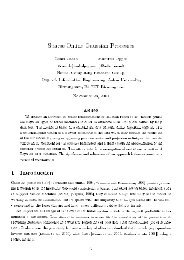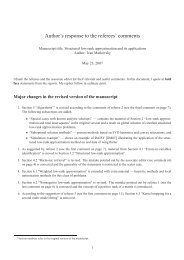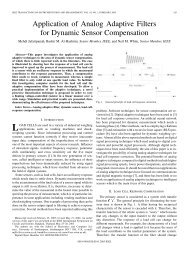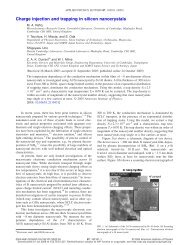Coherent and Differential Space-Time Shift Keying - ECS EPrints ...
Coherent and Differential Space-Time Shift Keying - ECS EPrints ...
Coherent and Differential Space-Time Shift Keying - ECS EPrints ...
Create successful ePaper yourself
Turn your PDF publications into a flip-book with our unique Google optimized e-Paper software.
SUGIURA et al.: COHERENT AND DIFFERENTIAL SPACE-TIME SHIFT KEYING: A DISPERSION MATRIX APPROACH 3229<br />
I E<br />
1.0<br />
0.8<br />
0.6<br />
0.4<br />
0.2<br />
= -2.0 dB to 3 dB<br />
SNR<br />
of 0.5 dB)<br />
(step<br />
QPSK<br />
CSTSK(2,2,2,4),<br />
RSC(2,1,2)<br />
200 000 bits<br />
Trajectory,<br />
= -0.5 dB<br />
SNR<br />
0.0<br />
0.4 0.6 0.8 1.0<br />
0.2 0.0<br />
Fig. 11. EXIT chart of our QPSK-modulated CSTSK(2, 2, 2, 4) system.The<br />
outer EXIT curve of the half-rate RSC(2, 1, 2) code was also plotted.<br />
b<br />
o<br />
l]<br />
2.0 m<br />
its<br />
/s<br />
y<br />
[<br />
b 1.5<br />
ity<br />
c<br />
1.0 a<br />
C<br />
a<br />
p<br />
3.0<br />
2.5<br />
0.5<br />
0.0<br />
0 5 10 15 20<br />
-5 -10<br />
I A<br />
QPSK, CCMC<br />
CSTSK(2,2,2,4),<br />
QPSK, DCMC<br />
CSTSK(2,2,2,4),<br />
QPSK, maximum achievable rate<br />
CSTSK(2,2,2,4),<br />
(M,)=(2,2), BPSK, DCMC<br />
SM,<br />
SNR [dB]<br />
Fig. 12. B<strong>and</strong>width efficiency of our CSTSK(2, 2, 2, 4) system employing<br />
QPSK modulation, comparing the CCMC capacity, the DCMC capacity <strong>and</strong><br />
the maximum achievable rate. The DCMC capacity of the BPSK-modulated<br />
SM employing (










